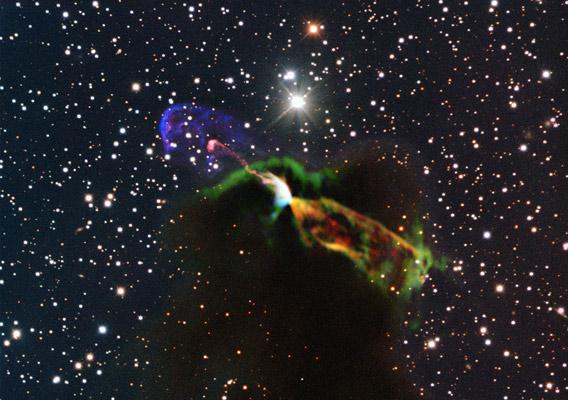You might think of stars as giant balls of gas in space that just kinda sit there, living out their lives, calmly emitting light and heat. But in fact—like most people, come to think of it—there’s hidden drama when you peek behind the curtain. In fact, with some stars, that’s literally true.
Take, for example, HH 47 IRS, a very young pair of stars orbiting each other. Located more than 1,000 light-years away and probably less than 1 million years old, these stars are in the act of finishing up their formation. Born in a dense, dark cloud, they are still embedded in a thick disk of material swirling around them.
Through forces still not entirely understood, the fierce energy emitted by the pair (about a dozen times the amount given off by the Sun) is focused into two beams, like those of a lighthouse, blasting out into space. The result is incredible beauty shaped from violence … and unless you use the right eyes, it’s invisible.
The image at the top of this post shows HH 46/47, the glowing gas blown out by the twin stars (technically called a Herbig-Haro Object, which is where the HH comes from). The image is a combination of pictures: a visible light shot from the ESO New Technology Telescope (NTT) and one in radio waves by the new ALMA radio telescope (colored green and orange for clarity). But if you look at just the NTT picture alone, you get a pretty different story:

Photo by ESO/Bo Reipurth
As you can see, in visible light, the lobe on the right is invisible, blocked by the chokingly thick cloud of dust and gas from which the stars were born.
But that material doesn’t absorb radio waves as efficiently, and they can pierce the veil. That flavor of light goes right through that matter, allowing us to see it using ALMA and investigate the other lobe. As it happens, the lobe on the right is made of material moving away from us and into the cloud, while the lobe on the left is headed more or less in to empty space toward us.
These observations have some interesting results, including determining that the gas is moving somewhat faster than previously thought, about 30–40 kilometers per second (about 70,000–90,000 miles per hour, which could get you from the Earth to the Moon in just a few hours). This means that over the lifetime of the stars they have injected a lot of momentum and turbulence into the gas cloud, stirring it up more than thought. Many such small, dense clouds have material flowing out of them, and this new study shows that these stars by themselves could drive the outflow from this cloud.
I’ll note that there have been other telescopes that have seen into this cloud before, including the Spitzer Space Telescope (more than once, actually). But this new observation shows the power and detail of the newly commissioned ALMA observatory, and what it can show us about star birth.
Incidentally, the ALMA observations show that the stars have emitted episodic eructations of gas; in other words there were some gaseous outbursts, and not just a steady flow. The knots of material ejected from the twins are moving at speeds that indicate they were blown out only a few hundred years ago, the blink of an eye on a cosmic scale.
Our Sun is pretty mature now, but it was young once, too. I imagine it looked a lot like HH46/47 about 4.5 billion years ago, when it was an infant only 1 million years in age. But given its demeanor and stately nature now, I certainly hope it wasn’t as impolite as HH 46/47, which has clearly irritated its mama cloud. And who wouldn’t get riled up if a pair of multiseptillion-ton babies were periodically burping matter into your face at supersonic speeds?
… assuming they were burping, of course. I’ll note that since one end is facing into the cloud, the other is therefore facing away. Which is which? This whole situation might be even ruder than we first thought.
More posts about Herbig-Haro objects (with stunning photos):
Hubble Celebrates 20 Years in Space With a Jaw-Dropper
C-Beams off the Shoulder of Orion
Newborn Star Makes a Cosmic Bank Shot
Spitzer Sees Star Spew Spurious Spouts
Baby Stars Blasting out Jets of Matter
